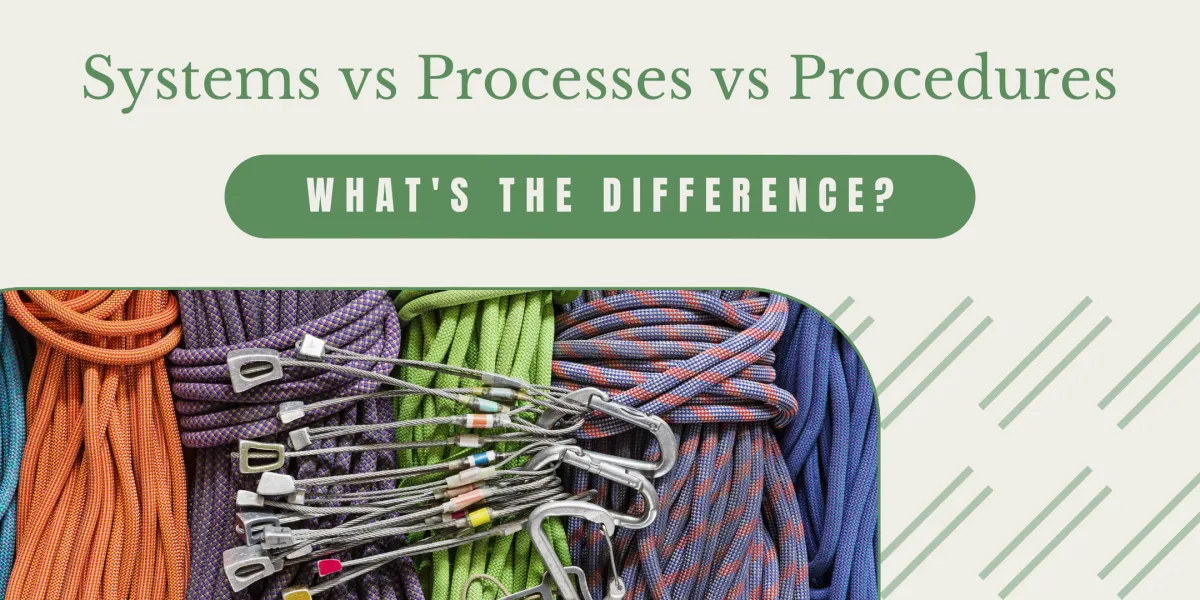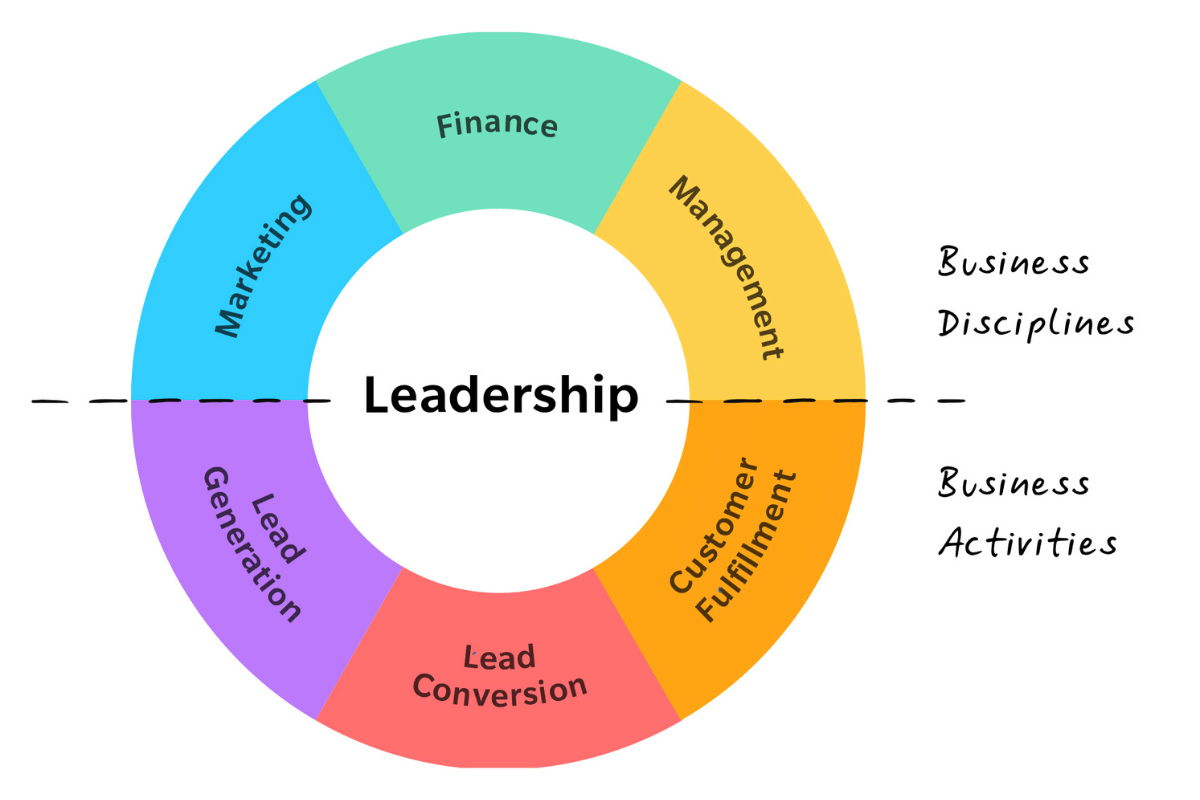
Defining Systems, Processes and Procedures
“When scaling a business, the key is to build systems and processes that can be replicated and automated to allow for sustainable growth.” - Damon John (Shark Tank)
“Scaling a business is all about building systems and processes.”
- Robert Kiyosaki (Rich Dad, Poor Dad)
“The ability to scale an organisation is directly related to its ability to delegate.” - John C. Maxwell (Leadership expert and author)
You’ve heard it everywhere, the key to scaling is establishing systems and processes so you can delegate. Especially when trying to get through one of the more difficult stages of revenue growth - from $1M to 3M. I was in a training call with Anik Singal who said, to scale through this tricky phase, entrepreneurs need to rely heavily on having systems and processes, be scrupulous about adhering to procedures, and not be distracted by new ideas, developing new products and the next shiny new thing.
But what are systems and processes exactly? Are they the same thing and how are they different to procedures?
What’s the Difference between Systems, Processes and Procedures?
It’s not so much their differences, but their relationship to each other: Systems are comprised of processes, and procedures are the detailed instructions for performing each step in the process.
But most people ask for the difference, so here are my specific definitions for each ...
Definition of a business system
A set of interconnected elements (processes, people, technology/resources, documentation and measurement) that work together to achieve a common goal.
A common alternative and short-sighted definition for a system is the technology used to carry out a process or task. A software application is indeed a system itself, but technology is just one element of a business system.
Definition of a process
A series of steps or actions taken to achieve a specific end result.
Often there is reference to a process transforming an input into an output (from manufacturing terminology), but this isn't always the case. A focus on the desired outcome or objective of the system provides enough direction to design a process that will achieve that.
Definition of a procedure
A specific, step-by-step set of instructions for carrying out a step in a process or completing a task.
Most often referred to as a Standard Operation Procedure (SOP) in business, much like a recipe is to cooking.
I’m a huge nerd in this area and live and breathe systems design, process management and SOPs every day, so I will share some more detail around the definitions of systems, processes, procedures and more that entrepreneurs should know.
And while I’ve been lucky enough to meet two of the three business experts quoted at the top of the page (John and Damon), and they are as passionate about systems and processes as I am, I know this can be pretty dry stuff if you're not systems geeks like us!

So, given our business is called ‘Harness’ (I met my husband/co-founder rock climbing), let’s use a rock climbing analogy to help illustrate these definitions and keep us all awake, shall we?!

Simply put, in our rock climbing analogy …
The process of rock climbing is the steps we go through to get from the bottom of a climb to the top (and back down safely!).
Assessing the route
Donning safety gear and climbing equipment
Communicating with our climbing partner
Climbing techniques used to scale the rock face
Rappelling back down, or walking off the back of the climb
At each of these stages there are also defined actions and protocols climbers follow to ensure safety and efficiency during their climb. These are procedures such as:
double-checking knots
belaying techniques
communication signals
All of which have fairly standard and widely accepted step-by-step instructions and/or checklists among climbers worldwide.
Which leaves us with the system - the interconnected elements that make up our solution (or system) for climbing the rock face:
The steps in the processes to achieve - what is required to get up the rock face
The procedures performed at each step - how we get up the rock face
The people involved and how they communicate (the climber and their belayer)
The equipment such as climbing shoes, harness, rope, belay devices
Route guides which show the way the rock face is intended to be climbed
Climb ratings which measure the difficulty of the climb
Now that we have that picture in our head, let’s break it down in a more business-like context, this time starting with systems.
What is a Business System? (with examples)

Source: A Business Owners Guide: Transform Your Business with Systems (EMyth).
We’ve already mentioned that a system is a set of interconnected elements that work together to achieve a common goal. A business itself is a system made of many subsystems (and more subsystems within those).
Systems are in fact just solutions that we design to solve problems. “How to climb a rock face” becomes “how to build a business to 9-figure revenue and beyond”. And we should be paying just as much attention to how we do this securely, safely and successfully for both!
Standing at the bottom of a looming wall of rock without a plan is daunting. Attempting to free climb it (with no safety equipment or support) is (in my opinion) only for fools gambling with their lives, have an eye-watering tolerance for risk or unflappable confidence in their skills and experience.

Sure, some adventurous entrepreneur types may relate to those qualities, but being in business is not a solo adventure. If you screw it up, it’s not just you, it can be the financial livelihoods of your team, your vendors and even your customers on the line.
So can business owners who want to be responsible entrepreneurs (and generally good humans) afford to be cavalier about how they run their businesses?
Short answer - no. They must create a system of systems that helps to maximise the activities and resources in their business to achieve the outcomes they want for themselves, their people, their customers and other stakeholders.

One of my favourite business experts is Michael E. Gerber, author of the original EMyth (back when I first read it) and now EMyth Revisited. The E stands for Entrepreneurial, the Myth part being that you don’t work IN your business as an entrepreneur, you work ON it.
Gerber offers a model of 7 Essential Systems comprising 4 business disciplines and 3 business activities. It’s a very clear and succinct way of demonstrating how a business is a system of subsystems. The 7 Systems are:
Leadership
Marketing
Finance
Management
Lead Generation
Lead Conversion
Customer Fulfilment
These system categorisations clearly show the key functions in a business, into which all activity can be sorted.
Examples of a Leadership System, Process and Procedure
Leadership is at the centre of your business as it leads and informs all parts of the business. As much as possible you want to move yourself out of the other systems and into this one, at the helm and heart of your business. So I’ll use this core system to provide some examples of a subsystem of Leadership: personal productivity and time management.
Elements of a Personal Productivity and Time Management System
How you manage your own time and productivity as a business owner has a huge impact on how well you can transition from working in your business to working on your business. Also don’t underestimate the value of modelling this to your team. Conversely, expecting your team to be productive, organised and efficient when you’re not, or to follow systems and processes that you don’t, will undermine your progress and credibility.
1) Process Example: Personal morning workflow

Your morning routine when you first start work helps to set up the day. Are you starting it in an adhoc and reactive way every morning, or do you have a process that places boundaries around your key priorities and activities that help you win the day?
2) Procedure Example: How to time block your priority tasks in ClickUp

This is just one procedure that helps in the process above. Any project or task management software you use should have the ability to help you surface your most important and urgent tasks. From this list you can determine your top priorities, and in ClickUp simply drag them into a scheduled time block on the calendar (which is connected to your Google or Outlook calendar). A simple Standard Operating Procedure (SOP) can show you and your team how they’re expected to check their tasks and time block for a more productive day.
3) Supporting Documentation Example: Inbox Triage Decision Tree

If you have an assistant helping to triage your inbox, providing them with a decision tree that guides when a task should be assigned to you, or worthy of time on your calendar can speed up your prioritisation process. A decision tree is just one example of documentation that supports the SOPs for a process. Others include:
Policies
Templates
Forms
Guidelines
Checklists
Scripts
Fact Sheets
This is not an exhaustive list by any means, but essentially, any information that supports the person carrying out each procedure in the process.
4) Technology Examples for Personal Productivity
Task or project management software (ClickUp, Asana, Jira, Gitscrum)
Calendar (Google Calendar, Outlook Calendar)
Time tracking software (Toggl, Harvest, native time tracking in your PM)
5) Role Examples: The People in your Personal Productivity System

You, of course! Every team member is at the centre of their own system.
Executive Assistants (help to manage requests for your time and triage task to help you prioritse)
Direct Reports (whom you can delegate tasks that don’t need to be on your desk)
6) Measurement Examples: Measuring Personal Productivity
Measurement is a vital part of every business system. It enables you to manage your business by its systems and how they are working together to achieve your top-level organisational objectives. Some examples of what to track for your personal productivity:
Time spent working on the business vs in it (use your time tracking software and categorise your tasks)
Distraction Time: Measure the time spent on non-work-related activities or distractions. Minimising distractions can lead to higher productivity levels.
Energy and Focus Levels: Assess how well you manage your energy and focus throughout the day. Maintaining high energy levels and sustained focus improves productivity and output quality. Tag tasks based on whether they energised you or drained you when completing them.
As you can see, these are just a few examples of the processes and elements in a personal productivity and time management system. Personal productivity and time management is just one sub-system of the Leadership system. To try and lay out every system in a business is quite the undertaking and too much for this blog post. However, there’s a reason I chose these specific examples today.
Leading your people in a systems and processes driven business
If you want to scale, franchise, replicate your business model, or sell your business it starts with systems and processes. Systemising your business IS quite the undertaking, but the returns on investment and effort often have a greater impact on your bottom line and achievement of goals than throwing money at inefficient lead generation or ‘A players’ to undertake sales activity and fulfilment.
The work starts with (but is not entirely done by) you. You need to take leadership, be methodical in your time management and how you model personal and business organisation to your team. This will enable you to switch out of working IN your business to working ON it, and eventually step OUT of it.

© 2022 Harness Online Business Management
© 2022 Harness Online Business Management

